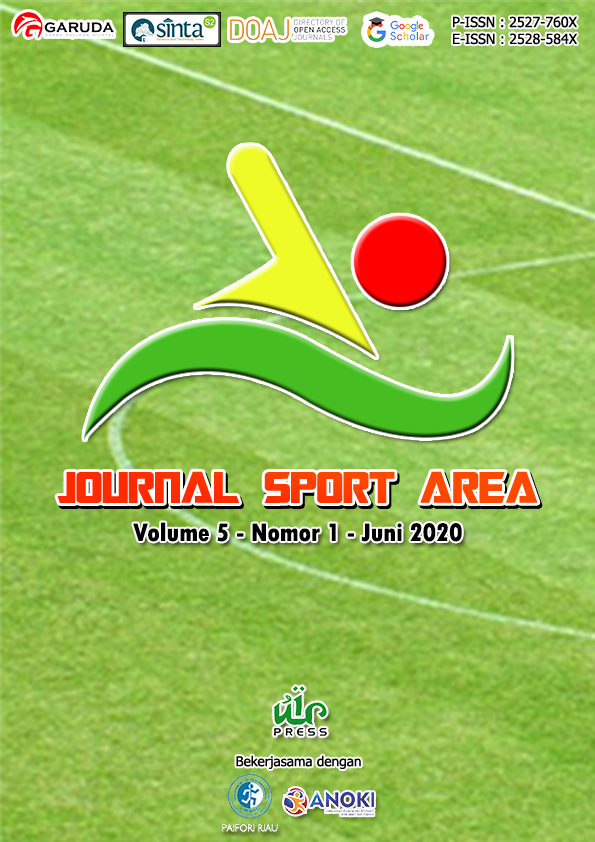The Effect of Direct Instruction Model in Physical Education Towards Students’ Adversity Quotient (AQ)
Keywords:
Physical Education, Learning Model, Direct Instruction, Adversity Quotient (AQ)Abstract
The purpose of this study is to determine the significance towards the effects of direct instruction in physical education and problem-solving skills to solve the problems faced by students (Adversity Quotient). The method applied is through group experiment using pretest and posttest design. The procedure for this research include observation, interview, treatment program preparation, analysis and conclusion. The research findings are achieved through group experiment with direct instruction model with significant influence towards students’ adversity quotient level with a score of (sig.), 000 < α=0,005. Based on the data, it can be concluded that the direct instructional model provide significant effect towards the level of students’ adversity quotient.
Downloads
References
Abduljabar, B. (2010). Landasan Ilmiah Pendidikan Intelektual dalam Pendidikan Jasmani. Bandung: Rizki Press.
Abduljabar, B. (2011). Modul Pedagogi Olahraga. Bandung: UPI Prodi PJKR.
Amri, S. & Ahmadi, I. K. (2010). Proses Pembelajaran Kreatif dan Inovatif Dalam Kelas. Jakarta: Prestasi Pustaka Publisher.
Bingquan, L., Weisheng, C., Xudong, Z., & Wenxiu, Z. (2019). The Compilation of The Adversity Quotient Scale for College Students. Psychology and Behavioral Sciences, 8(1), 9-14. https://doi.org/10.11648/j.pbs.20190801.12
Edgen, P. & Kauchak, D. (2012). Strategi dan Model Pembelajaran. Jakarta: PT Indeks.
Gall, M.D., Gall, J.P., & Borg, W. R. (2013). Educational Research. USA: Pearson Education, Inc.
Khairani, A. Z., & Abdullah, S. M. S. (2018). Relationship between adversity quotient and academic well-being among Malaysian undergraduates. Asian Journal of Scientific Research, 11(1), 51–55. https://doi.org/10.3923/ajsr.2018.51.55
Maksum, A. (2012). Metodologi Penelitian dalam Olahraga. Surabaya: Unesa University Press.
Metzler. M. W. (2000). Instructional Models For Physical Education. London: Allyn & Bacon.
Mwivanda, M., & Kingi, P. M. (2019). Teachers’ Adversity Quotient Dimension of Control and Students Academic Performance in Secondary Schools in Kenya. Journal of Education and Training, 6(1). https://doi.org/10.5296/jet.v6i1.14373
Napis, N. (2018). Analysis of Physics Problem Solving in The Perspective of Self Efficacy and Adversity Quotient. Formatif: Jurnal Ilmiah Pendidikan MIPA, 8(1), 31-42. https://doi.org/10.30998/formatif.v8i1.2298
Okorji, P. N., & Epetuku, F. (2019). Relationship Between Principals Adversity Quotient and Leadership Styles in Secondary Schools in Delta State, Nigeria. International Journal of Scientific and Research Publications (IJSRP), 9(7), 938-945. p91123. https://doi.org/10.29322/ijsrp.9.07.2019.p91123
Rusman. (2012). Model-Model Pembelajaran. Jakarta: PT. RajaGrafindo Persada.
Stoltz, P. G. (2010). Adversity Quotient Mengubah Hambatan Menjadi Peluang. Jakarta: PT Gramedia.
Yakoh, M., Chongrukasa, D., & Prinyapol, P. (2015). Parenting Styles and Adversity Quotient of Youth at Pattani Foster Home. Procedia - Social and Behavioral Sciences, 205. https://doi.org/10.1016/j.sbspro.2015.09.078
Published
How to Cite
Issue
Section
This is an open-access article distributed under the terms of the Creative Commons Attribution-ShareAlike 4.0 International License which permits unrestricted use, distribution, and reproduction in any medium. Copyrights of all materials published in Journal Sport Area are freely available without charge to users or / institution. Users are allowed to read, download, copy, distribute, search, or link to full-text articles in this journal without asking by giving appropriate credit, provide a link to the license, and indicate if changes were made. All of the remix, transform, or build upon the material must distribute the contributions under the same license as the original.
Accepted 2020-04-15
Published 2020-06-03












